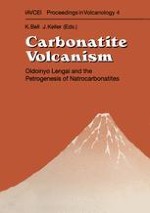1995 | OriginalPaper | Chapter
What Are the Parental Magmas at Oldoinyo Lengai?
Authors : T. D. Peterson, B. A. Kjarsgaard
Published in: Carbonatite Volcanism
Publisher: Springer Berlin Heidelberg
Included in: Professional Book Archive
Activate our intelligent search to find suitable subject content or patents.
Select sections of text to find matching patents with Artificial Intelligence. powered by
Select sections of text to find additional relevant content using AI-assisted search. powered by
At Oldoinyo Lengai, all of the carbonate lavas, and most of the silicate lavas, are highly fractionated with low Mg number (Mg#) and very high alkali content. Experimental studies have demonstrated that natrocarbonatite can be produced by liquid immiscibility from strongly peralkaline nephelinites, which are found at Oldoinyo Lengai in close association with natrocarbonatite. If natrocarbonatite is formed by liquid immiscibility from a CO2-saturated silicate magma, the origin of that magma is clearly the outstanding petrogenetic problem at Oldoinyo Lengai. Existing 1-atm experimental data on the crystallization of primary alkaline, ultrabasic magmas (olivine nephelinite and olivine melilitite) and petrological studies on eruptive examples indicate that the derivatives of olivine melilitites and melilite nephelinites can be strongly peralkaline ([Na+K]/A1≥1.5) and frequently contain wollastonite, a common phenocryst phase in nephelinites at Oldoinyo Lengai. Olivine melilitites occur at Oldoinyo Lengai and at young tuff cones nearby; these have alkali contents that are abnormally high, even for these rocks. Olivine melilitites cannot fractionate to form phonolites; relatively low-alkali phonolites at Oldoinyo Lengai were probably formed by crystal fractionation and crustal contamination of olivine nephelinite, which is also sparsely represented there. Oldoinyo Lengai is an excellent example of extreme igneous fractionation, but cannot stand as a general model for carbonatite petrogenesis because its parental magmas are rare in alkaline centres.
